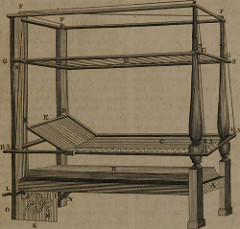Nematodes (also known as Nemathelmintes) are roundworms with a cylindrical body and a complete digestive tract including mouth and anus. They are unsegmented, pseudocoelomate worms. The body is covered with a noncellular, highly resistant coating called a cuticle, which is molted as they grow. Nematodes have separate sexes; the female is usually larger than the male. The male typically has a coiled tail. The medically important nematodes can be divided into 2 categories according to their primary location in the human body, namely intestinal and tissue nematodes.
Ascaris lumbricoides
Causes ascariasis. It is distributed worldwide. The Adult worms are creamy or pink, spindle-shaped, covered by striated cuticle. Adult male about 20cm in length, posterior end is curved ventrally; adult female about 25-40cm in length, posterior end is straight. Eggs are brown, oval, covered by membranes. An external membrane is tuberous. Mode of transmission is through fecal-oral (alimentary). Humans are infected by eating eggs in soil contaminated with human feces. Eggs hatch in the small intestine, and the larvae migrate through the gut wall into the bloodstream and then to the liver, heart and lungs. They enter the alveoli, pass up the bronchi and trachea, and are swallowed. Within the small intestine larvae become adult worms. Thousands of eggs are laid, are passed in the feces, and form embryos in warm, moist soil.
Clinical manifestations are as follows
1. Migrating larvae may lead to pneumonia, eosinophilia
2. Adults in the intestine may cause intestinal obstruction, penetration of the intestinal wall, occlusion of the bile duct, the pancreatic duct or the appendix, toxic effects (nausea, vomiting). Most infections are symptomatic. Laboratory diagnosis include microscopic examination of feces (eggs are oval with an irregular surface); larvae may be found in sputum.
Prevention is done by washing hands before meals; proper washing of vegetables eaten raw; treatment of patients; proper disposal of feces; health education.
Enterobius Vernicularis
It causes enterobiasis. It is distributed worldwide. Adult female worms are up to 10mm in length, and male worms are up to 5mm. Eggs are transparent and colorless, asymmetrical, with thin and smooth membrane, 40-60 micrometer. Mode of transmission is through the fecal oral route (alimentary). Infective stage of Enterobium vermicularis is the eggs. The adult pin-worms live in the large intestine approximately 30 days. After fertilization, female worms migrate from the anus and release thousands of fertilized eggs on perianal skin. Within 6 hours, eggs develop into larvae and become infectious. Reinfection can occur if they are carried to the mouth by fingers after scratching of the itching skin.
Infection is frequent among children under 12 years of age. Perianal pruritis (itching is most common symptom. Laboratory diagnosis is based on the determination of the eggs recovered from perianal skin by using the “scrotch tape” technique and can be observed microscopically (eggs are not found in the stools). Seldom adult worms can be found in the stools. Prevention is possible by keeping sanitary conditions and treatment of patients with anti parasitic drugs such as mebendazole or albendazole.
Trichuris trichuria
It causes trichocephaliasis (whipworm infection). It occurs worldwide, especially in the tropics. Adult female worms are up to 5.5cm in length, and male are up to 4cm. The anterior end of the body is hair-like. The eggs are brown, barrel-shaped with a plug at each end, 20-50micrometer in size.
Mode of transmission is through the fecal-oral route (alimentary). Infective stage-eggs. Eggs hatch in the small intestine; larvae become adults in few days, migrate to the large intestine. Adults mate, and produce thousand of eggs daily. Immature eggs pass in the feces, and form embryos in warm, moist soil. Embryonated eggs may be ingested through contaminated water, raw vegetables an hands.
Adult worms burrow their hair-like anterior ends into the intestinal mucosa. They feed blood. Trichuris may cause diarrhea, abdominal pain, nausea, acute appendicitis etc. Most infections are asymptomatic. Laboratory diagnosis is based on microscopic examination of feces (finding the typical eggs). Prevention is done by washing of hands before meals; proper washing of vegetable eaten raw; treatment of patients; proper disposal of feces and health education.
I am Funom Theophilus Makama. I advertise through writing. As a platinum expert Author, I write lots of articles and hence promote interested websites, companies, groups, organizations, and communities through publishing and distributing my articles. For more information on this interesting venture, click on the link below
http://funom-makama.blogspot.com/2010/07/advertising-contracts.html
I am an expert Author and writer. I write, publish, re-publish and distribute very good articles around the internet. With professional techniques, such as SEO, social bookmarking, social netowrking, Google ads and more, I am able to generate traffic thereby aiding me to advertise products, companies, websites, groups, communities etc. Hence I advertise through writing and distribution of articles

